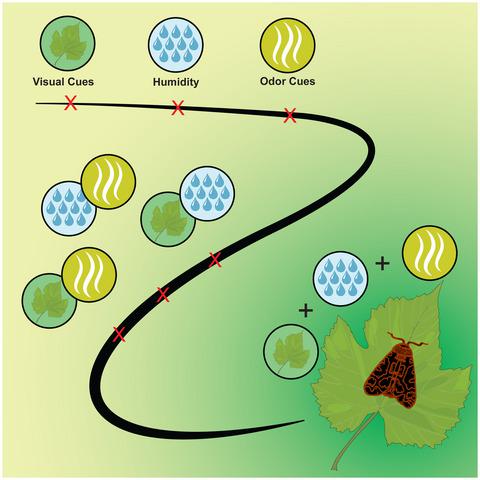当前位置:
X-MOL 学术
›
Entomol. Exp. Appl.
›
论文详情
Our official English website, www.x-mol.net, welcomes your feedback! (Note: you will need to create a separate account there.)
Habitat cues synergize to elicit chemically‐mediated landing behavior in a specialist phytophagous insect, the grape berry moth
Entomologia Experimentalis et Applicata ( IF 1.9 ) Pub Date : 2020-12-01 , DOI: 10.1111/eea.13003 Michael S. Wolfin 1, 2 , Ronald R. Chilson 1 , Jonathan Thrall 3 , Yuxi Liu 3 , Sara Volo 3 , Dong H. Cha 4 , Gregory M. Loeb 1 , Charles E. Linn 1
Entomologia Experimentalis et Applicata ( IF 1.9 ) Pub Date : 2020-12-01 , DOI: 10.1111/eea.13003 Michael S. Wolfin 1, 2 , Ronald R. Chilson 1 , Jonathan Thrall 3 , Yuxi Liu 3 , Sara Volo 3 , Dong H. Cha 4 , Gregory M. Loeb 1 , Charles E. Linn 1
Affiliation

|
Many phytophagous insects locate their host plant using mixtures of volatile compounds produced by the plant. A key behavior in the host location process that has been the focus of decades of behavioral research is optomotor anemotaxis. Another key step in host location is landing on (or near) the odor source. In previous work, rubber septa emitting a synthetic blend of volatiles extracted from young shoots of grape plants, Vitus spp. (Vitaceae), elicited equivalent levels of oriented upwind flight by female grape berry moths (GBM), Paralobesia viteana (Clemens) (Lepidoptera: Tortricidae), as did actual (control) grape shoots. However, in contrast to the shoots, females did not land on the odor source. In this study, we used flight tunnel assays to investigate the landing response of GBM females with respect to chemical and visual stimuli, as well as differences in relative humidity. When stimuli were presented individually, only the synthetic blend of host plant volatiles elicited equivalent levels of oriented upwind flight compared to the plants. Interestingly, wet cotton strips elicited low but consistent levels of upwind flight. In paired assays, only the synthetic blend paired with wet cotton strips elicited landing, although at significantly lower levels than that elicited by grape shoots. To achieve landing rates equivalent to live grape shoots, grape berry moth females required all three stimuli we tested: host odor cues, moisture, and visual cues simulating a grape shoot. These results suggest the cues have a synergistic effect, and that landing behavior requires complex sensory processing using multiple sensory inputs. Furthermore, these results suggest that moisture plays an important role in the host plant location process.
中文翻译:

栖息地线索协同作用,在一种专门的植食性昆虫葡萄浆果蛾中引发化学介导的着陆行为
许多植食性昆虫使用植物产生的挥发性化合物的混合物来定位它们的寄主植物。几十年来一直是行为研究焦点的宿主定位过程中的一个关键行为是光运动性趋向性。宿主位置的另一个关键步骤是落在(或靠近)气味源上。在之前的工作中,橡胶隔垫释放出从葡萄植物幼芽中提取的合成混合物,Vitus spp。(Vitaceae),由雌性葡萄浆果蛾(GBM),Paralobesia viteana(Clemens)(鳞翅目:Tortricidae)引起等效水平的定向逆风飞行,实际(对照)葡萄芽也是如此。然而,与芽相比,雌性没有落在气味源上。在这项研究中,我们使用飞行隧道分析来研究 GBM 雌性对化学和视觉刺激的着陆反应,以及相对湿度的差异。当刺激物单独呈现时,与植物相比,只有宿主植物挥发物的合成混合物引起了相同水平的定向逆风飞行。有趣的是,湿棉条引起了低但一致的逆风飞行水平。在配对试验中,只有与湿棉条配对的合成混合物引起着陆,尽管其水平明显低于葡萄芽引起的水平。为了达到与活葡萄芽相当的着陆率,雌性葡萄浆果蛾需要我们测试的所有三种刺激:寄主气味线索、水分和模拟葡萄芽的视觉线索。这些结果表明这些线索具有协同效应,着陆行为需要使用多个感官输入进行复杂的感官处理。此外,
更新日期:2020-12-01
中文翻译:

栖息地线索协同作用,在一种专门的植食性昆虫葡萄浆果蛾中引发化学介导的着陆行为
许多植食性昆虫使用植物产生的挥发性化合物的混合物来定位它们的寄主植物。几十年来一直是行为研究焦点的宿主定位过程中的一个关键行为是光运动性趋向性。宿主位置的另一个关键步骤是落在(或靠近)气味源上。在之前的工作中,橡胶隔垫释放出从葡萄植物幼芽中提取的合成混合物,Vitus spp。(Vitaceae),由雌性葡萄浆果蛾(GBM),Paralobesia viteana(Clemens)(鳞翅目:Tortricidae)引起等效水平的定向逆风飞行,实际(对照)葡萄芽也是如此。然而,与芽相比,雌性没有落在气味源上。在这项研究中,我们使用飞行隧道分析来研究 GBM 雌性对化学和视觉刺激的着陆反应,以及相对湿度的差异。当刺激物单独呈现时,与植物相比,只有宿主植物挥发物的合成混合物引起了相同水平的定向逆风飞行。有趣的是,湿棉条引起了低但一致的逆风飞行水平。在配对试验中,只有与湿棉条配对的合成混合物引起着陆,尽管其水平明显低于葡萄芽引起的水平。为了达到与活葡萄芽相当的着陆率,雌性葡萄浆果蛾需要我们测试的所有三种刺激:寄主气味线索、水分和模拟葡萄芽的视觉线索。这些结果表明这些线索具有协同效应,着陆行为需要使用多个感官输入进行复杂的感官处理。此外,



























 京公网安备 11010802027423号
京公网安备 11010802027423号